
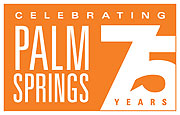 Some of the best history, characters, and color of Palm Springs unfold in its distinctive neighborhoods from the traditional ones developed from the 1920s until shortly after World War II to the midcentury modern enclaves designed by now-iconic architects such as Wexler, Frey, Cody, Palmer and Krisel, and others.
Some of the best history, characters, and color of Palm Springs unfold in its distinctive neighborhoods from the traditional ones developed from the 1920s until shortly after World War II to the midcentury modern enclaves designed by now-iconic architects such as Wexler, Frey, Cody, Palmer and Krisel, and others.
The city recognizes 32 neighborhoods and has plans to designate more “official” ones. And recently installed signs — Indian Canyons, Deepwell, Movie Colony, etc. — now mark them to celebrate their history and to help people gain a broader sense of the Palm Springs communities.
If the names confuse newcomers to the area, they’re in good company. Folks who have been here for a half-century and longer often disagree on which names are traditional and which were recently concocted.
“It was more inclusive then,” says Jim Hicks, a fourth-generation resident whose great-grandfather Alvah Hicks helped launch two of the city’s most prized neighborhoods: Old Las Palmas and Little Tuscany. “Growing up in Palm Springs, we never thought much about neighborhoods.”
Jim Hicks lived in Las Palmas as a youngster in what today is known as the Liberace House. He remembers much of the area was undeveloped. It was so laid back during World War II, residents didn’t flinch at the sound of gunfire from an army officers’ practice range tucked into the mountain apron behind what is now Vista Las Palmas.
“Everyone looked out for everyone else,” says Hicks, whose family founded Palm Springs Water Company, the forerunner to Desert Water Agency. “If your dog was found downtown, you would get a call to come pick him up. We went everywhere on our bicycles — Jurgensen’s grocery, the drugstore soda fountain in the village, and roads east into the desert.
“We thought of ourselves as one community,” he continues. “We came together from all over the city to support events such as Desert Circus and the annual Police Variety Show.”
The city’s abundance of welcoming, non-gated neighborhoods is often cited as a reason Palm Springs has always had such a strong sense of community. Celebrities and other affluent visitors who walled themselves into their permanent homes elsewhere relaxed in this inclusive paradise and joined in the fun.
The Police Variety Show was so important to celebrities that actor Charlie Farrell, who founded the Racquet Club and was later elected mayor, had an agreement with his TV and film producers allowing him to leave a production if it was time for this annual show.
Hicks and other longtime residents hope the proliferation of new neighborhoods, with their individually sponsored events, only adds to the community’s identity and social interaction.
Official neighborhood designation from the city actually begins with a movement by residents. Residents set the boundaries, name the area (sometimes based on historic neighborhoods), and petition the city.
Agreeing on the historic neighborhoods is much more difficult.
Sally McManus grew up in Palm Springs and is the former curator, historian, and director who assisted the late Betty Kieley, civic leader and descendent of pioneer Nellie Coffman, in establishing the Palm Springs Historical Society’s downtown McCallum Adobe museum.
“There were very few recognized neighborhoods,” McManus recalls from her childhood. “What is now called the Movie Colony was known as Tamarisk Park because of Ruth Hardy Park, which was a very big deal when it was dedicated. Tamarisk Road was the main street that took you across town. [Avenida] Caballeros was a dirt road that led to the stables where McManus kept her horse. Caballeros dead-ended where Tahquitz Canyon Way is today.”
Jim Hicks, a Realtor, says the neighborhood names actually help market the communities. “Not only do we have The Movie Colony today — a name with great appeal for the area — but real estate agents keep expanding the boundaries.”
Other neighborhoods that were recognized early on were Las Palmas, Little Tuscany, Smoke Tree Ranch, The Mesa, The Tennis Club, Araby Cove, Deepwell, and Bel Desierto and Veteran’s Tract, known today as El Mirador and Demuth Park neighborhoods, respectively.
“The high school kids of the ’50s loved Little Tuscany,” McManus laughs. “It had gorgeous views, and it’s where everyone went to park and neck.”
Retired banker Wanda Hird, writer Sharon Apfelbaum, and former HOA management firm owner Jody Allen have lived in the city since the 1960s. They agreed on a slightly different list of historic neighborhoods: Las Palmas, Movie Colony, Little Tuscany, Tennis Club, Mesa, Araby, Deepwell, Smoke Tree Ranch, the Canyon area (the street signs call it Canyon Corridor), Southridge, Gateway Highlands, and Vista Las Palmas.
Disagreements no doubt will continue among locals about the nomenclature, authenticity, and boundaries of Palm Springs’ historic neighborhoods. Most will agree, however, on the importance of the architecture, midcentury modern or otherwise, and, as the British would say, “the worthies” who lived there.
With so many neighborhoods now vying for historic status, our list focuses on a history that begins prior to 1950.
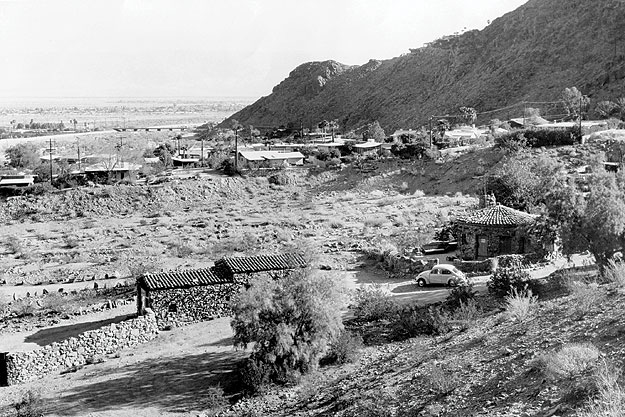
Araby Cove with Lee Miller’s house
ARABY COVE
Minutes from East Palm Canyon Drive off Araby Road — east of Farrell Drive but seemingly a world away — this unpretentious, offbeat enclave gradually reveals its 80 eclectic homes from a narrow winding road that crosses the wash. Many are built up from the road to capture views from their aerie perches. Some homes are cabin-like and date to the early 1920s. Others range from ranch-style to modern. Historically, major storms have washed out the main access road. For decades, Araby Cove’s landmark was Neel’s Nursery — until it was finally closed as Palapas and became the site of Pintura condos.
OLD LAS PALMAS
Large gated estates with tile roofs, privacy walls, mature landscaping, and rural roadways characterize the most prized neighborhood in Palm Springs. Boasting houses that the late architecture historian Patrick McGrew described as Desert Spanish, Old Las Palmas was subdivided by El Mirador Hotel developer P.T. Stevens, who teamed with contractor Alvah Hicks and his son Harold Hicks during the mid-1920s to build spec homes designed by William Charles Tanner. Prominent architects such as Myron Hunt and Wallace Neff also contributed to the architectural legacy. Old Las Palmas, with about 300 houses, is located between Palm Canyon Drive and Monte Vista and bordered by Stevens Road on the north and Alejo Road on the south. Notable residents included Kirk Douglas, Gene Autry, Kirk Kerkorian, Lena Horn, Lily Tomlin, Jack Warner, Lawrence Harvey, George Hamilton, Mary Martin, and Edgar Bergen.
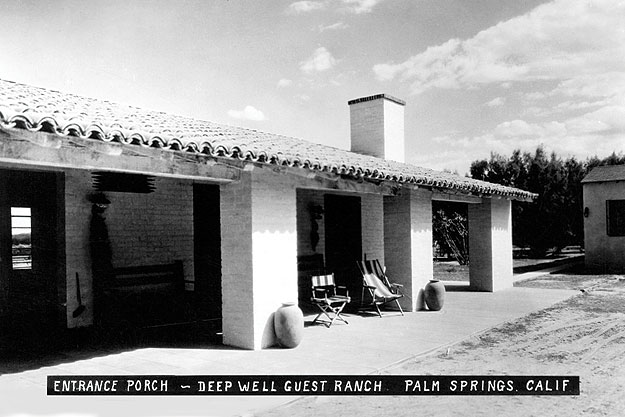
Deepwell Ranch, 1928
DEEPWELL
When Henry Pearson purchased an apricot ranch in 1926, he drilled the deepest well in the Coachella Valley, stopping at 630 feet. He also built a ranch house with a glass-covered pipe roof system that used solar energy to heat water. Later converted to the popular Deep Well guest ranch, much of the surrounding area became subdivided, starting in the early 1950s as Deepwell Colony Estates. Large ranch-style and modern houses, many with guesthouses, were built in the meticulously landscaped neighborhood. By the early 1970s, developer Bill Bone had built his gated Spanish-style Deepwell condos on the original ranch property near its western border. Famous residents included Loretta Young and her couture designer husband Jean Louis. General borders are Mesquite Avenue on the north, East Palm Canyon Drive on the south, Sunrise Way on the east, and Deepwell Road on the west.
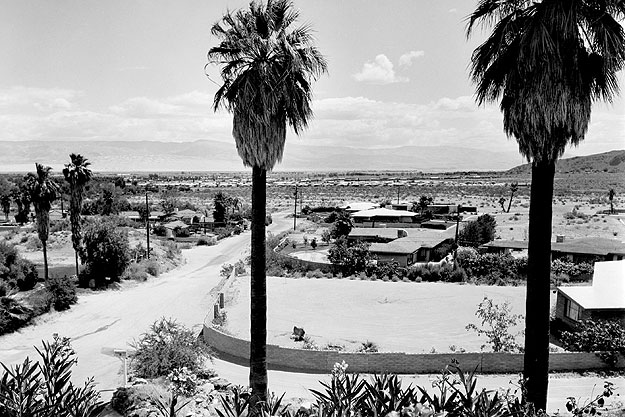
The Mesa, photographed from the Ship of the Desert
THE MESA
Desert dwellers who love hillside living are drawn to the views and seclusion of The Mesa, with its narrow, winding streets and divergent architectural styles. Founded as a private gated area in the 1930s, the overall plan failed when the developer died suddenly. Part of the never-occupied gatehouse still stands. Residents include the late former Mayor Howard Wiefels and Agua Caliente Tribal Chief Richard Milanovich. You’ll find The Mesa west of South Palm Canyon Drive past Moorton’s Botanical Garden en route to the Indian Canyons. The Mesa is bordered by the mountain on the west, El Camino Way on the north, and Laverne Way on the south.
LITTLE TUSCANY/CHINO CANYON
The old teenage lover’s lane has had a proper affair with architectural mavens for decades. The hilly boulder-strewn land at the mountain base has appealed to independent personalities willing to experiment with residential design. Builder Alvah Hicks gave the area its name when he returned from Tuscany, Italy, in 1934, enamored with its stone artisan construction. Hicks built seven Tuscany-inspired homes among the boulders. U.S. Senator Warren Magnuson owned one, and Elvis Presley owned another. Many of the 20th century’s greatest architects were inspired when building homes here: Richard Neutra’s famous Kaufmann House, 1946; J.P. Clark and Albert Frey’s Loewy House, 1946; Edward H. Fickett’s May House, 1951; E. Stewart William’s Edris House, 1953; Craig Ellwood’s Palevsky House, 1968; Michael Black’s Edna Root Shapiro House, 1969; and James McNaughton’s Kramer House, 1969. Famous residents: Jolie, Magda, Zsa Zsa, and Ava Gabor; Elvis; President John F. Kennedy; Rosalie and Patty Hearst; composer Ernst Krenek; McDonald’s Ray Kroc; Howard Hughes; and Jack Benny. The locale is bordered by West Chino Canyon Road on the north, Vista Chino on the south, the apron of Mount San Jacinto on the west, and Via Norte on the east.

Palm Springs Tennis Club in the 1940s
Vic Culina
THE TENNIS CLUB DISTRICT
Known for its charming, independently owned boutique hotels, the district traces its origins back to a small hotel called Casa Cody. A Class One Historic Site, Casa Cody continues to welcome visitors. Hotel founder Harriett Cody moved here in 1916 with her consumptive husband Harold Bryant Cody, an architect associated with Myron Hunt. Walkable to downtown, the area quickly became a tourist favorite, attracting more small hotels over the years. Today, it has more than 25, many of them also historic. “Auntie Pearl” McCallum McManus, Palm Springs pioneer and daughter of Judge John McCallum, bought back much of the land her father lost during a drought. She built her pink house near today’s Palm Springs Tennis Club, which she founded in 1937 with its hillside Bougainvillea Room and most-photographed round pool. She also donated land for the area’s Women’s Club and allowed land to be subdivided for village pied-a-terre living. Harold Matzner now owns the tennis club and popular Spencer’s Restaurant. The area is bordered by South Palm Canyon Drive on the east, mountains on the west, Tahquitz Canyon Way on the north, and Ramon Road on the south.

Walt Disney and his wife review plans for their home in Smoke Tree Ranch.
SMOKE TREE RANCH
This gated private enclave of fewer than 100 houses has preserved its natural desert landscaping since day one. The exclusive, family-oriented ranch was founded in 1925 as the Smoke Tree Forest Company on 400 acres in the south end of Palm Springs. It has always attracted captains of industry, including creative geniuses such as Walt Disney, who donated the ranch’s Disney Hall. Residents are “colonists,” and they mark their street addresses with enumerated rocks. The ranch-style homes are unpretentious, and some colonists own extra lots for privacy. Since the colony includes a stable and originally had dusty unpaved roads, western wear was the uniform from the earliest days. Morning rides and moonlit steak dinners were popular with residents and visitors to its guest ranch. Properties rarely go on sale and typically are snapped up by friends and relatives. Dining today at Smoke Tree Ranch is an elegant experience, and old-timers love to talk about the days when individually engraved clothespins were used as place settings. Smoke Tree Ranch is south of East Palm Canyon Drive and Sunrise Way, secluded from view by Smoke Tree Shopping Center and Smoke Tree Commons. President Dwight Eisenhower, a guest of Paul Helms, founder of Helms Bakery, and Paul Hoffman, CEO of Studebaker Corp., are among the neighborhood’s famous visitors. Cary Grant, although not a colonist, regularly rode his horse on the ranch.
TAMARISK / RUTH HARDY PARK
Renamed The Movie Colony and Movie Colony East in recent years, the neighborhood was known for decades as Tamarisk or Ruth Hardy Park, a favorite among tennis lovers and the site of the fire department’s annual fish fry. Film stars flocked to area from the 1930s, especially after Darrell F. Zanuck won a Tamarisk Road estate from United Artist’s Joseph Schenck in a poker game. The director introduced many stars to Palm Springs when he invited them to spend weekends at the compound, which had a huge guesthouse and bar-centered great room. A favorite lawn activity was competitive croquet. The games became so boisterous that the neighbors often called the police. Today, homes range from modest to palatial within the two neighborhoods. Historic boundaries are Vista Chino to the north, Alejo Road to the south, Indian Canyon Drive to the west, and Sunrise Way on the east. The height of residential star power was from the 1930s through the 1960s: celebs include Frank Sinatra, Bob Hope, Bing Crosby, Dinah Shore, Steve Lawrence and Eydie Gorme, and Keely Smith.
BEL DESIERTO
El Mirador Hotel was an outpost when P.T. Stevens built the popular vacation spot in 1929. As homes were built around it, Stevens named the neighborhood Bel Desierto. The Army transformed the hotel into Torney General Hospital to treat soldiers returning from the South Pacific with tropical diseases during World War II. It was given to the community after the war and expanded as Desert Hospital in 1952. The original hotel bell tower has symbolized the hospital (now Desert Regional Medical Center) for years, and was rebuilt in 1991 to the original architectural blueprints after it was destroyed by fire. Walkable to downtown, Ruth Hardy Park, and the Wellness Park, the neighborhood offers good value and varied architecture. Renamed El Mirador, the historic Bel Desierto neighborhood is bordered by Chia Road on the north, Tachevah Road on the south, Via Miraleste on the west, and Via Caballeros on the west.
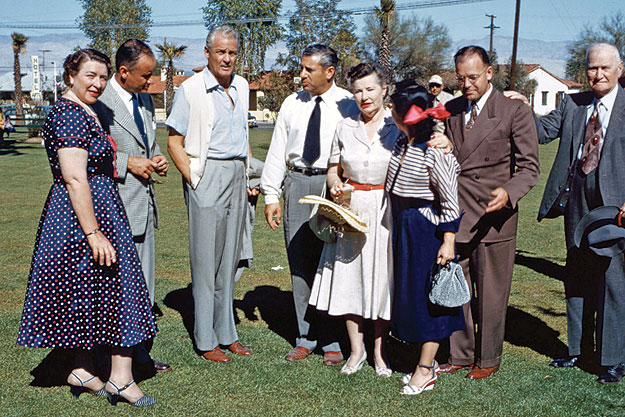
Dedication of Demuth Park in 1953 at its original location where Palm Canyon Drive and Indian Canyon Drive meet. Ruth Hardy is on the left. Mayor Charlie Farrell is third from left.
Winfield Line
THE VETERAN’S TRACT
Palm Springs, like most post World War II communities, suffered a housing shortage for its working residents and returning veterans. There was also a shortage of building materials, and it took two years to obtain lumber for the new tract south of the airport runways. A blow to many buyers was a six-month delay caused when 2 million board feet of scarce lumber went up in flames at the site. Frank Broes became a local hero when he saved half the wood by bulldozing a firebreak down the middle. The Veteran’s Tract was renamed for Demuth Park, the recreational area at its southern border. The 65-acre park draws families from throughout the Coachella Valley for soccer, picnics, baseball, and tennis. It also is home to the city’s new animal shelter. The park is the perfect amenity for the Demuth Park Neighborhood, whose residents are mostly permanent working families. With Mesquite Avenue at its south end, Demuth Park is bordered by Ramon Road on the north, El Cielo Road on the west, and Gene Autry Trail on the east.
Neighborhood Watch
Committee enables city to partner with its residents
Palm Springs Neighborhood Involvement Committee — the city sanctioned organization designed to “build strong communication partnerships between the city and recognized neighborhoods and their residents” — is only eight years old. The idea for the committee bubbled up from city council and staff, and it started with eight groups in 2005. It expanded to 32 in 2012, and several more are in the pipeline for this year.
“The Palm Springs program, I believe, is a model for the country — both from a public policy standpoint and overall good governance,” says City Manager David Ready, who has been meeting with neighborhood groups since before the committee’s inception. “It institutionalizes the partnership we have with the neighborhood by setting standards for participation and a steering committee structure.”
Ready says neighborhoods give vital feedback on how to better provide city services.
Warm Sands, a neighborhood south of Ramon Road noted for its small gay-oriented hotels, is a good example of how PSNIC can enhances neighborhoods. PSNIC improved sidewalks, helped it obtain its landmark Jungle Red sculpture, supported its Neighborhood Watch, and helped to block the opening of a 24-hour convenience store.
The neighborhoods also socialize, take on improvement projects, and advise other groups in formation.
Lee Bono was the city’s public information officer when the program launched. Bono’s combination of enthusiasm, patience, and cool demeanor soon made her the perfect city liaison. Bono was appointed director of neighborhood and community relations.
Bono makes it clear that groups wanting to set up organizations and establish boundaries must be inclusive of all residents, including apartment and mobile home residents within or adjacent to the area.
One of the most popular organizational perks is the assignment by the city of designated neighborhood beat officers. Ready says the program improves transparency and helps the city focus early on potential problems.
There is an emotional factor for the staff as well. “There now is a deeper recognition for myself and staff about how city hall decisions impact individual citizens,” he adds.
Distinctive “blade” signs designed by the neighborhoods and affixed to street signs herald the program throughout the city. The sanctioned neighborhood organizations as of January 2013 are:
- Andreas Hills
- Araby Commons
- Araby Cove
- Baristo
- Canyon Corridor
- Chino Canyon
- Deepwell Estates
- Demuth Park
- Desert Highland Gateway
- Desert Park Estates
- El Mirador
- El Rancho Vista
- Four Seasons
- Historic Tennis Club
- Indian Canyons
- Los Compadres
- Mountain Gate
- Movie Colony East
- Old Las Palmas
- Parkview Mobile Estates
- Racquet Club Estates
- Racquet Club South
- Racquet Club West
- Sonora Sunrise
- Sunmor
- Sunrise Vista Chino
- Tahquitz River Estates
- The Mesa
- The Movie Colony
- Vista Las Palmas
- Vista Norte
- Warm Sands

